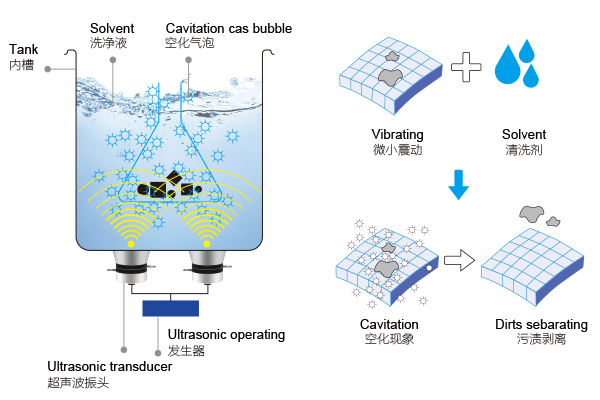About ultrasonic emulsification, I briefly introduce, under the action of ultrasonic energy, two (or more than two) mutually insoluble liquids are uniformly mixed to form a dispersion, where one liquid is uniformly distributed in another liquid into a milk state.

Ultrasonic emulsification principle
With other ultrasonic cleaning principles, ultrasonic emulsification is also caused by cavitation. Ultrasonic waves through the liquid so that it is constantly compressed and expanded. High-intensity ultrasound provides the energy required to disperse the liquid phase. When a certain pressure is reached, the liquid ruptures at the point of weaker cohesion. After this rupture, an overpressure occurs at the rupture and a number of cavities are created. In these cavities, the liquid dissolved gas explodes as bubbles in a short time.
In order to stabilize the newly formed droplets of the dispersed phase to prevent agglomeration, emulsifiers (surface active substances, surfactants) and stabilizers are added to the emulsion. The resulting droplet size distribution is maintained at the same level as when the droplet breaks up in the ultrasonic dispersion zone.
The cavitation process is influenced by the ultrasonic frequency and intensity. The appearance of in vivo cavitation depends to a large extent on the presence of undissolved gas in the suspension. The presence of gas seems to act as a catalyst. The formation of cavities at a certain pressure depends to some extent on the development time and ultrasonic frequency. The ultrasonic emulsification process represents a competition between opposing processes. Therefore, it is necessary to choose the appropriate operating conditions and frequencies so that the destructive effect prevails.
What are the advantages of ultrasonic emulsification?
1、The type of emulsion can be controlled.
2、The power required to produce the emulsion is small.
3、The emulsion formed is relatively stable, some can be stable for several months to more than six months.
4、High concentration, pure emulsion concentration up to 30% or more, emulsifier up to 70%.
5、low cost, an important feature of ultrasonic emulsification is that it can produce very stable emulsions without or with less emulsifier.
6、compared with general emulsification techniques and equipment (such as propeller, colloid mill, homogenizer, etc.), ultrasonic emulsification has many advantages.
7、The average droplet size of the formed emulsion is small (0.2~2 microns) and the droplet size distribution range is narrow (0.1~10 microns) or narrower.
Application of ultrasonic emulsification
According to a large number of successful customer cases, ultrasonic cleaning machine emulsification applications are very wide, such as the pharmaceutical industry, industrial fields, daily necessities and other industries. Ultrasonic emulsification often produces a variety of emulsified products, such as cosmetics, shampoo, leather shoe polish and other common ones.
One of the impressive industries is the food processing industry. For example, the following products: mayonnaise, jam, chocolate, human-made cheese; the use of ultrasonic emulsification of these foods to process, to overcome the artificial food processing process of unclean and unhygienic phenomenon.
Ultrasonic emulsification is widely used in various industries at home and abroad to improve product quality and speed up production efficiency. With the continuous progress of science and technology, more and more companies continue to deepen understanding of ultrasound, the application of ultrasound.



